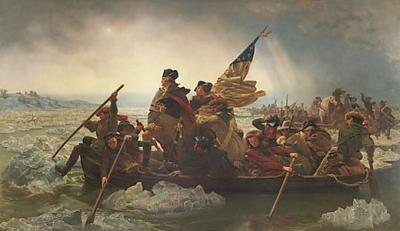This month, EDSITEment looks at December celebrations, Emanuel Leutze’s depiction of George Washington’s December crossing of the Delaware, a collection of Civil War resources, and civil unrest in Newark, New Jersey, in the 1960s.
Gift of Holiday Traditions: Kwanzaa, Hanukkah, and Christmas
Each year, December brings a month filled with holidays, celebrations complete with a variety of gift giving traditions, and—to the glee of students and educators alike—school vacations. Before departing to enjoy the break from school, take the opportunity to discuss with students ritual gift giving in their own families and across cultural holiday traditions. Some questions to have them consider:
• How do individual families customize their holiday celebrations with gift exchanges and other rituals?
• In what ways does holiday gift giving figure in the popular imagination through great literature that is re-read and performed year after year?
• Trace holiday traditions especially the practice of gift giving as it unfolds over time—can common themes and elements can be found within different spiritual traditions?
Discover December Holiday Traditions from Mexico
Find out about poinsettias, posadas, and piñatas on Thinkfinity Community. When the Spanish Europeans came to America, they were introduced to the culture, art, and agricultural products native to the Americas. Likewise, indigenous people in what is now Mexico were exposed to many practices from Europe that were new to them as well. This encounter between the Old and New Worlds illustrates what can happen When Worlds Collide, a multimedia NEH-funded, EDSITEment-reviewed resource. Students may discover how native people held fast to their indigenous roots, while also embracing Christianity through one of the best examples of cultural duality, the vision and worship of the indigenous Madonna, Lady of Guadalupe.
Washington Crosses the Delaware

Brrrrr!!! What a way to spend the holidays! On Christmas Night, December 25, 1776, George Washington led Continental army soldiers across the Delaware River to attack Britain’s Hessian army at Trenton, New Jersey. This successful surprise attack provided a much-needed victory for Britain’s former colonies as they struggled for freedom.
At the mention of this event, most Americans picture a heroic George Washington standing in a small boat. That’s how Emanuel Leutze pictured it in his huge painting, Washington Crossing the Delaware, that has been reproduced in history textbooks and hung in American classrooms for the past 150 years.
But there are a lot of surprises about this most famous icon of American history. First, a German artist painted it in response to German politics. Emanuel Leutze, born in Germany in 1816, moved to America as a child, but returned to Germany to study art in 1840. With a strong belief in liberal democracy, he painted this American Revolution scene to inspire German reformers. When his first painting of Washington’s crossing became popular in Europe, he shipped this second huge version to the United States in 1851. It became an instant success with more than fifty thousand people coming to see it. Today it is owned by the Metropolitan Museum of Art.
The American Civil War
Whether it is called the Civil War, the War between the States, the War of the Rebellion, or the War for Southern Independence, the events of the years 1861–1865 were some of the most traumatic in the nation’s history.
The secession of the southern states, and President Lincoln’s decision to prevent them forcibly from leaving the Union, triggered a conflict that would see fighting on battlefields as far apart as Pennsylvania and Texas, Missouri and Florida, and would leave nearly a million Americans on both sides dead or wounded. Indeed, casualties in the Civil War exceeded those of every other war in which the United States has ever participated, combined.
EDSITEment has put together a collection of our lesson plans, student interactives, multimedia presentations, and vetted websites that will allow teachers, students, parents and lifelong learners to learn more about these events.
Revolution ’67
Newark, New Jersey, is one of thousands of American cities to experience civil unrest during the 1960s. Often forgotten by textbooks and in American memory generally, the riots of the 1960s provide teachers with an excellent opportunity to highlight a wide variety of important themes in U.S. history such as conflict and protest as well as the transition from the civil rights era to Black Protest movement.



